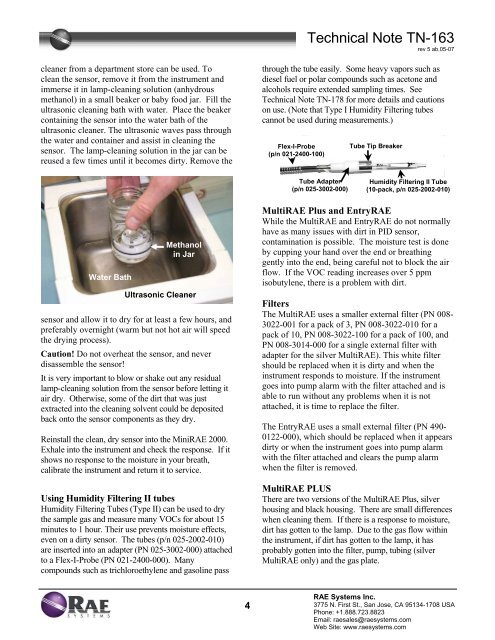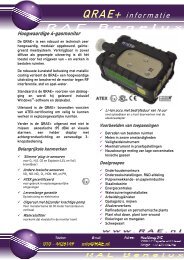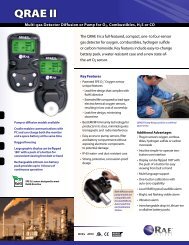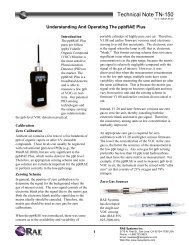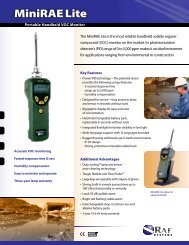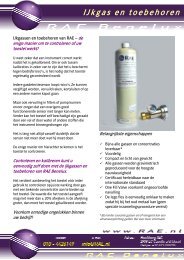Create successful ePaper yourself
Turn your PDF publications into a flip-book with our unique Google optimized e-Paper software.
Technical Note TN-163<br />
rev 5 ab.05-07<br />
cleaner from a department store can be used. To<br />
clean the sensor, remove it from the instrument<br />
and<br />
immerse it in lamp-cleaning solution (anhydrous<br />
methanol) in a small beaker or baby food jar. Fill the<br />
ultrasonic cleaning bath with water. Place the beaker<br />
containing the sensor into the water bath of the<br />
ultrasonic cleaner. The ultrasonic waves pass through<br />
the water and container and assist in cleaning the<br />
sensor. The lamp-cleaning solution in the jar can be<br />
reused a few times until it becomes dirty. Remove the<br />
through the tube easily. Some heavy vapors such as<br />
diesel fuel or polar compounds such as acetone and<br />
alcohols require extended sampling times. See<br />
Technical Note TN-178 for more details and cautions<br />
on use. (Note that Type I Humidity Filtering tubes<br />
cannot be used during measurements.)<br />
Flex-I-Probe<br />
Tube Tip Breaker<br />
(p/n 021-2400-100)<br />
Tube Adapter<br />
(p/n 025-3002-000)<br />
Humidity Filtering II Tube<br />
(10-pack, p/n 025-2002-010)<br />
Water Bath<br />
Methanol<br />
in Jar<br />
Ultrasonic Cleaner<br />
sensor and allow it to dry for at least a few hours, and<br />
preferably overnight (warm but not hot air will speed<br />
the drying process).<br />
Caution! Do not overheat the sensor, and never<br />
disassemble the sensor!<br />
It is very important to blow or shake out any residual<br />
lamp-cleaning solution from the sensor before letting it<br />
air dry. Otherwise, some of the dirt that was just<br />
extracted into the cleaning solvent could be deposited<br />
back onto the sensor components as they dry.<br />
Reinstall the clean, dry sensor into the MiniRAE 2000.<br />
Exhale into the instrument and check the response. If it<br />
shows no response to the moisture in your breath,<br />
calibrate the instrument and return it to service.<br />
Using Humidity Filtering II tubes<br />
Humidity Filtering Tubes (Type II) can be used to dry<br />
the sample gas and measure many VOCs for about 15<br />
minutes to 1 hour. Their use prevents moisture effects,<br />
even on a dirty sensor. The tubes (p/n 025-2002-010)<br />
are inserted into an adapter (PN 025-3002-000) attached<br />
to a Flex-I-Probe (PN 021-2400-000). Many<br />
compounds such as trichloroethylene and gasoline pass<br />
MultiRAE Plus and EntryRAE<br />
While the MultiRAE and EntryRAE do not normally<br />
have as many issues with dirt in PID sensor,<br />
contamination is possible. The moisture test is done<br />
by cupping your hand over the end or breathing<br />
gently into the end, being careful not to block the air<br />
flow. If the VOC reading increases over 5 ppm<br />
isobutylene, there is a problem with dirt.<br />
Filters<br />
The MultiRAE uses a smaller external filter (PN 008-<br />
3022-001 for a pack of 3, PN 008-3022-010 for a<br />
pack of 10, PN 008-3022-100 for a pack of 100, and<br />
PN 008-3014-000 for a single external filter with<br />
adapter for the silver MultiRAE). This white filter<br />
should be replaced when it is dirty and when the<br />
instrument responds to moisture. If the instrument<br />
goes into pump alarm with the filter attached and is<br />
able to run without any problems when it is not<br />
attached, it is time to replace the filter.<br />
The EntryRAE uses a small external filter (PN 490-<br />
0122-000), which should be replaced when it appears<br />
dirty or when the instrument goes into pump alarm<br />
with the filter attached and clears the pump alarm<br />
when the filter is removed.<br />
MultiRAE PLUS<br />
There are two versions of the MultiRAE Plus, silver<br />
housing and black housing. There are small differences<br />
when cleaning them. If there is a response to moisture,<br />
dirt has gotten to the lamp. Due to the gas flow within<br />
the instrument, if dirt has gotten to the lamp, it has<br />
probably gotten into the filter, pump, tubing (silver<br />
MultiRAE only) and the gas plate.<br />
4<br />
RAE Systems Inc.<br />
3775 N. First St., San Jose, CA 95134-1708 USA<br />
Phone: +1.888.723.8823<br />
Email: raesales@raesystems.com<br />
Web Site: www.raesystems.com


